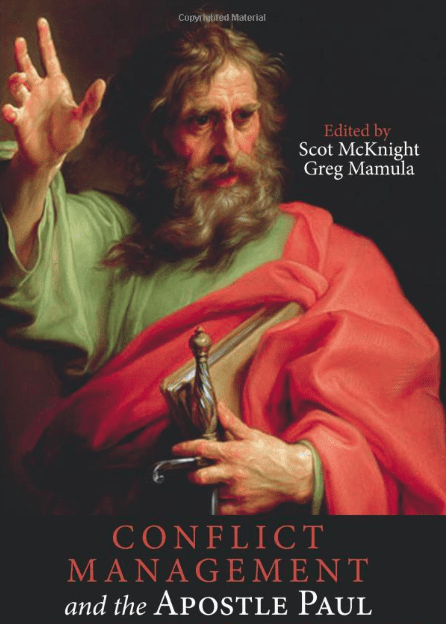 How does the apostle Paul stack up to best practices in modern conflict management? My DMin cohort that just graduated explored this question but it required that we look at modern conflict management theory: See McKnight and Mamula, Conflict Management and the Apostle Paul.
How does the apostle Paul stack up to best practices in modern conflict management? My DMin cohort that just graduated explored this question but it required that we look at modern conflict management theory: See McKnight and Mamula, Conflict Management and the Apostle Paul.
From Lauren Visser and Greg Mamula’s introduction chapter … (abbreviated with some slight reformatting for the blog) … I will summarize three more of the five approaches [see here for the first two] of their helpful literature review… now from their chapter.
The Family Systems Approach
They focus on Cosgrove and Hatfield’s approach in this section of their survey.
[heir thesis is that “behind the official systems of the local church (its offices, boards, committees, etc. there is another system, a family-like system, which powerfully determines the way that church members relate to one another, do business together, care for one another, and fight with one another.”
, Cosgrove and Hatfield offer four truths related to church conflict management: “First, the congregational system is interconnected. . . . Second, the congregational system is both dynamic and stable. . . . Third, the congregational family is already organized to care for its own members. . . . Fourth, the psychic life of the individual is not only private (‘internal’) but also social.”
Cosgrove and Hatfield then offer several different strategies^P^tors can employ when engaging with their congregation under the umbrella of family systems theory. One, they can employ strategic insider action, which is acting from within the family system to suggest change. Two, they can use the focused strategy, which aims at getting to the root of the problem since the seemingly most pressing issues are not also the most significant ones. Three, they can affiliate, which means decreasing the distance between different people or groups by positively identifying with them. Four, they can use unbalancing tactics to form new coalitions that restructure the system and eliminates conflict.25 The fifth and last strategy that Cosgrove and Hatfield offer is that of joining, through affirmation and identification.
The Reconciliation Approach
John Paul Lederach … In describing his process of peacemaking and reconciliation, Lederach shares his own stories, and he cautions against forming enemies. He lays out three steps that go into creating enemies: “First, to construct the image of the enemy, I must separate myself from them [Second,] I see myself as superior…. Third, separation and superiority lead to dehumanizing the other person(s).” Lederach cautions against such distancing, and he reminds Christians in conflict that if they look to find God in others, they will be unable to turn them into an enemy.
In order to provide practical steps for managing conflict from a biblical perspective, Lederach unpacks Matt 18. His four steps are: go directly to the person with whom you have a problem, bring two or three witnesses along, tell the problem to the church, and relate as with a Gentile or tax collector. Lederach comments how the first two steps are found in family systems theory, as described above by Cosgrove and Hatfield. Lederach also emphasizes Acts 15 as a source for biblical principles, and he notes six steps for managing conflict from this passage: “recognize and define the problem . . . create the appropriate forum for processing matters … let diverse viewpoints be represented… document diversity… use the gifts of the community… [and] decide, then implement decisions.”
Starting with the Bible (Approach)
Christian conflict manager Karl Slaikeu takes the principles from Fisher and Ury,34 and like Lederach, he interacts with Matt 5 and Matt 18 as a way of managing conflict. Slaikeu uses these two Scripture passages as the foundation for his Preferred Path process of interpersonal conflict management.
… first, if you are aware you are in conflict with another person, it is your responsibility to go to them and seek reconciliation. … If going one-on-one does not resolve the conflict and bring about reconciliation and restoration, you are invited to bring in outside help. … If bringing observers does not work, you are to bring in the church body. This is a stage where modern conflict management fits. The idea that an extra voice can be brought into the procedure sometimes helps to resolve the conflict. There are three outcomes to this type of outside involvement. The first is mediation, where the church conflict manager seeks to resolve the issue in a wise and efficient manner while restoring the relationships of those in conflict with one another and the rest of the church. The second possible solution is arbitration. Arbitration is the process of an outside party listening to all the parties involved and then casting a ruling on future steps. The final possible outcome is that of litigious settlement. Some sort of outside legal ruling party will settle the matter. The problem with arbitration and litigation is that while it might result in a fair or even wise verdict, it does little to maintain the relationship between the conflicted parties. If the offending party does not listen to the voice of the church, then the third and final solution is separation, to treat them like a “pagan or tax collector.’
[Then Visser and Mamula turn to another Bible-approach, that of James Christensen and Thomas Johnson:] Christensen and Johnson share several New Testament conflict management themes. The first is the dictum or arbitration, where a defined announcement by a recognized authority seeks to settle the matter with a ruling. … The second way the New Testament deals with conflict is through the process of separation. Separation ends the dispute but does not lead to reconciliation. … A third New Testament conflict management theme is avoidance. Avoidance includes accepting the wrong of others without retaliation. … Fourth, conflict is dealt with through the process of negotiation. Negotiation requires a trained, neutral third party who facilitates a process. … Finally, some form of arbitration in the form of official church action is described in the New Testament. Some sort of outside authority makes a decision.











